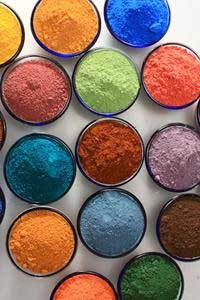Types of Pigments Used inside Printing

A pigment can be a powder that will enables you to definitely make various colors and styles. It can also be used as being an ink. There are really several sorts of pigments that are utilized in the printing procedure. Let's learn concerning them. It is important to recognize the process utilized to prepare the pigment before applying it to paper.
pigment dust
Pigment dust is actually a versatile and inexpensive way to add color in your color or other product or service. This powder is certainly safe and works best for transparent topcoats. It is powder consistency permits you to mix and sprinkle easily. Most pigment powders come inside short metal tins which can be convenient to store. This is particularly beneficial for people with limited space.

Granello and pigment powder snow could be mixed together to create different seems. These two powders usually are made from normal stone minerals. Mica contains shiny flakes that are typically ground into natural powder and used regarding metallic and pearl-like effects. Those who use Mica powder found in their art tasks should use extreme caution whenever using it because it could be a possible irritant. Additionally it is important to wear the dust mask whilst working with pigment powder, as this kind of powder could be extremely reactive.
Mica powder is a popular alternative to pigment powdered for artists. It has additional profit of having some sort of longer shelf life. The powder will not deteriorate or change color any time mixed with the liquid. In add-on, it is compatible with all types of paints and resins. You can even use it to produce colored chalks.
Pigment powder can also be mixed with a binding to produce a variety of painting media. infusible ink of binding depends on the variety of pigment you utilize. Some paint manufacturers also sell metallic pigment powder for a shimmering effect.
pigment ink
When a person print documents or even photographs, you'll almost certainly want to choose a pigment ink more than a dye ink. These inks are much better for the surroundings and do not harm the paper fiber. Pigment inks are usually in powdered kind, while dyes are liquids. Pigment inks require more labor to produce, but are more durable.
Pigment ink is the particular preferred choice for professional photographers in addition to artists who need the best output feasible. It's also archival and resistant to UV rays and scratching. This ink produces consistent, abundant blacks and whites across a large variety of press. In addition, this offers the best results for B&W pictures. The downside of using pigment ink is it tends to appear rather less vibrant as compared to dye ink.
Another great thing about pigment ink is that it's water-repellant. This means it can ideal for labeling products or outdoor clothes. Additionally, it won't bleed or ghost about paper, which makes it perfect for official files. Another benefit regarding pigment ink is usually its excellent level of resistance to light in addition to a long life.
Pigment ink consists of various types of pigments. There are inorganic and organic pigments. Most of these types of materials come by natural sources. A few are made by mineral precursors or refined in some sort of laboratory. They're next processed to improve their own functionality or colour.
color pigment
Color pigment could be the element that gives color its color. There are many different types of pigment available, including reddish, green, blue, and even yellow. Each features different properties. The blue range is usually dominated by phthalocyanine pigments, while natural consist of copper phthalocyanine pigments. The almost all common way in order to get green is usually by mixing yellow and blue colors. The type of green pigment utilized depend upon which brightness wanted and economics.
A pigment is a particulate substance of which is insoluble throughout water, and the liquid or strong substance that consists of this pigment will be transparent or perhaps opaque. Pigments can change color by selectively absorbing and spreading light. These materials give a stuff its color, and are frequently used in paint, plastics, in addition to other materials.
Mixing up colored pigments along with achromatic pigments can adjust the hue. White, aluminum, and disturbance pigments are instances of achromatic pigments. When mixed with discolored pigment, a series of mixing between the two occurs. This specific mixture produces the hue that leans towards olive putting surface. Colored pigments could also connect to various other colors in a similar manner.
Colour pigments contain unsaturated bonds. This form associated with bonding is named a conjugated system. Another kind of colour pigment is named an auxochrome, which usually contains lone sets of electrons. This specific coloration is derived from a chemical reaction involving phenols and fresh air in the ambiance.
